Editor of this issue: Violeta Kelertas
Copyright © 1999 LITUANUS Foundation, Inc.

|
LITUANUS
LITHUANIAN QUARTERLY JOURNAL OF ARTS AND SCIENCES
Volume 45, No. 4 - Winter 1999
Editor of this issue: Violeta Kelertas ISSN 0024-5089
Copyright © 1999 LITUANUS Foundation, Inc. |

|
THE SINFONIA GIOCOSA (1990) BY TEISUTIS MAKAČINAS: NEOCLASSICISM AND THE FOLKLORIC
ENRIQUE ALBERTO ARIAS
De Paul University
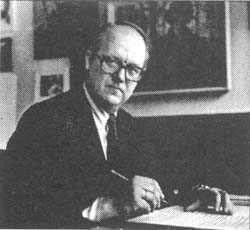
The present article analyzes Teisutis Makačinas's Sinfonia Giocosa both in terms of its Neoclassicism and its relationship to the styles of Lithuanian folk music. This fine work, in four movements, exemplifies the composer's later style through its economy, contrapuntal texture, modal harmonies, and cyclic structure.
I first met Makačinas in 1993, when I visited the GAIDA Festival of contemporary music in order to meet some of Lithuania's major composers. As a result of this visit, I wrote articles for Lituanus and other journals on Osvaldas Balakauskas, Raimundas Katilius, and the organ sonatas of Makačinas.1 I returned to Lithuania again in 1995 to attend the GAIDA festival. This offered me a further opportunity to research Lithuanian music.2
Makačinas's music is striking for a number of features. In general, it avoids the extremely experimental in favor of what one could call a personal brand of Neoclassicism. Deeply influenced by Lithuanian folk music, Makačinas uses motivic repetition, modal melodic lines, and contrapuntal elaboration of melodic cells derived from the folkloric tradition. Tension is produced by bitonal or polytonal chords and by dissonant counterpoint. Quartal harmonies (again derived from the folk tradition) play a vital role. The rhythmic language is deceptive. Because of the predominance of eighth and quarter notes, the rhythms seem relatively simple; but a closer analysis of phrase lengths, rhythmic groupings, and changing meters demonstrates sophistication and intricacy.
Textures tend to be strongly contrapuntal. In this regard, Makačinas has long taught counterpoint, and his interest in Renaissance-Baroque patterns of polyphony is evident in his compositions. Although movements or sections may begin simply, they grow in tension and density through contrapuntal elaboration, often with bitonal implications.
Structures are clear and are often influenced by Baroque patterns. In this regard, one is reminded of Paul Hindemith, one of the principal figures in twentieth-century Neoclassicism.
Neoclassicism
In order to understand Makačinas's use of Neoclassicism, I offer the following brief overview. Musical Neoclassicism consists of a clear use of past styles and forms, usually those of the 18th century. This outlook is already present in Brahms, who deeply venerated Bach and the Viennese classical composers. Eighteenth-century practices are evident in many of Brahms's compositions, such as the Haydn Variations for orchestra (1873), which ends with a passacaglia. Other composers of the later nineteenth century also looked to the past for inspiration. Tchaikovsky's Rococo Variations for cello and orchestra (1876) and Grieg's Holberg Suite for string orchestra (1884) are but two of many instances that could be cited.
In the twentieth century, Neoclassicism is most closely associated with the compositions of Stravinsky and Hindemith. The term Neoclassicism was first used in the present sense by Boris de Schloezer in a review of a concert given in 1923 and organized by Jean Wiener.3 Neoclassicism, developing many political and cultural connotations, was then associated principally with Stravinsky. Stravinsky's Pulcinella (1920), a ballet written for Serge Diaghilev and based on compositions ascribed to Giovanni Pergolesi, is the landmark work in Neoclassicism. Its staccato textures and transformation of the model works, usually with motivic development and the addition of dissonance, influenced many composers of the 1920s. But such compositions as Ferruccio Busoni's Fantasia Contrapuntistica (1910) and Max Reger's orchestral Variations and Fugue on a Theme by Hiller (1907) are also important for their Bachian polyphony and thus anticipate Stravinsky's masterpiece.
Ferruccio Busoni, was one of the principal spokesmen for the aesthetics of Neoclassicism. In an essay entitled "Young Classicism," (1920) Busoni wrote: "By 'Young Classicism' I mean the mastery, the sifting and turning to account of all gains of previous experiments and their inclusion in strong and beautiful forms."4 Thus "young classicism" is seen to be the opposite of exaggeration. It is both old and new at the same time and is marked by the dominance of melody (through polyphony), objectivity, "serenitas," refinement, and economy. It considers the oneness of music and prefers absolute to descriptive music. It will be seen during the course of the present article that all these qualities are present in the Sinfonia Giocosa.
As mentioned previously, Paul Hindemith was one of the leaders in Neoclassicism. Hindemith and Makačinas have much in common. The frequent emphasis on strong motor rhythms, quartal harmonies, and folk song references relate the two composers. Hindemith's Kammermusik series for strings and various solo instruments (1922-27) comes to mind as similar to the Sinfonia Giocosa because of its orchestration, its division into clearly structured movements, and its references to Baroque antecedents.
Ernest Bloch's Concerto Grosso No. 1 for piano and strings (1925) also relates to the Sinfonia Giocosa. Both works mirror eighteenth-century practices and both use the same instrumental combination - although, as we shall see, the piano is handled quite differently in the Sinfonia Giocosa. More recently, Alfred Schnittke has written a Concerto grosso No. 6 for Piano and Strings (1993), in which the piano plays an integral role within the texture, but is given more soloistic prominence than in the Sinfonia Giocosa.
Lithuanian Folk Music
An equally important and fertile influence on Makačinas's music in general and on the Sinfonia Giocosa in particular is that of Lithuanian folk music. One often hears of the expressive monotony and melancholy of Lithuania's folk melodies. Mikalojus K. Čiurlionis (1875-1911), the great composer and painter, defined salient features of Lithuanian folk songs. He wrote: "The monotony of rhythm is one of the most important - and so to say - the most beautiful peculiarities of our songs. This simplicity awakens a solemn mood. And when one listens longer, one is aware of a deep, mystic character."5 Čiurlionis himself employed Lithuanian folk melodies in his symphonic poem Das Meer (1903-08) and in the Prelude for Piano Op. 33, No. 3 (1909).6
Repeated pitches, conjunct melodic cells, and references to modality are typical. Heterophony (or the chance creation of polyphony through improvisation) can create surprising harmonic frictions. Thus this extemporaneous polyphony creates stringent dissonances and pungent texture. Performances seem to have emphasized a straight tone of voice, without vibrato and with strong accents on key words.
As might be expected, folksongs are closely related to dances. The following quotation from the Lithuanian Culture Center Web site underlines this connection:
Among the oldest Lithuanian folk dances are the sutartinės. Their characteristic feature is the repetition of onomatopoetic words and polyphony of the text and music (simultaneous sounding of different words and melodies). The sutartinė (song) is accompanied by simple movements of a dance - walking, stamping feet, gliding, changing places, coming, turning, and others. The most characteristic figures are walking in rows, facing each other, or going in a circle. Sutartinės were mostly danced by women. The name of such a sutartinė would derive from the first line of the song or its refrain. This type of sutartinės were still danced in north-eastern Lithuania in the early 20th century.7
Very often these songs are for women's voices and fulfill the needs of given functions. Work songs and songs for special occasions, such as births and marriages, are characteristic, but the texts generally sing of sadness and of the power of fate.8
In a letter to me of 7 July 1999, Makačinas wrote:
I would like to draw your attention to the rich spring of Lithuanian folksong. There are songs for funerals, songs of sadness, and songs of crying. These are lamenting recitations in the monodic style using a sophisticated system of unstable, modal rhythms in a narrow melodic range. You will notice this style in my music.

Example 1.
These songs of crying open up a fantastic area for artistic games.
Because of the pervasive influence of the folkloric, one can speak of a sort of Minimalism among Lithuanian composers. Independent of the development of Minimalism in the United States by such composers as Steven Reich, Terry Riley, Philip Glass, and John Adams, Lithuanian composers have employed Minimalism. Pattern repetition of simple ideas, ostinato rhythms, and diatonic harmonies prevail. The results may sound like that of their American counterparts, but the roots are different. As we will see, the Sinfonia Giocosa includes this kind of Minimalism.
Makačinas's biography
Makačinas was born in Kaunas in 1938. He graduated from the Lithuanian Music Academy in 1961, where he studied composition with Julius Juzeliūnas. He is presently professor at the Lithuanian Music Academy, where he teaches an integrated course of music theory (counterpoint, harmony, and analysis of musical forms). In 1973 he became the head of the music theory and composition department at the Lithuanian Conservatory. In addition to his work as composer, Makačinas is involved in theoretic studies, presently with an emphasis on Baroque instrumental polyphony. The Sinfonia Giocosa won the Lithuanian Chamber Orchestra prize.9
Analysis of the Sinfonia Giocosa
Sinfonia Giocosa is Italian for joyous or happy symphony. The use of the term sinfonia is significant, for it implies an earlier 18th-century style. One associates the term with the Italian overtures of Alessandro Scarlatti and the development of the symphony before the mature works of Haydn and Mozart. That Makačinas scores the Sinfonia Giocosa for piano and strings reflects this earlier practice. The piano acts as a kind of basso continuo by providing rhythmic and harmonic support, but its percussive nature underlines the many dissonances of the score.
The Sinfonia falls into four movements: Allegro, Moderato, Andante Rubato, Presto. Each movement continues gently into the next through either a transition or incomplete cadence at the end of the movement. Overall unity is achieved through clear relationships among the movements of thematic material and texture. Fortspinnung is the principal means of evolving texture. This is to say that an initial gesture is presented simply, but undergoes continuous extension and development as the movement progresses.
The first movement begins with a repeated D-C gesture. (Ex. 2) This folk-like motive dominates the movement, b'ut also provides material for the Sinfonia as a whole. At Rl (R=Rehearsal mark) the pattern expands to a Lydian mode on C, thus emphasizing the C-F# tritone. The whole step and Lydian mode prevail until R5, where the texture becomes more dissonant and energetic. Increasingly one hears a Db-Eb motive, an idea that will be heard at the end of the Sinfonia. At RIO, the material from R5 returns and is expanded as this movement reaches a climax at Rll. Here, the strings present an idea in parallel triads that highlights the increasing rhythmic activity. This section also blends and elaborates the motivic cells that had been introduced previously in the work. At R13, an insistent chordal pattern brings this section of the movement to a close.
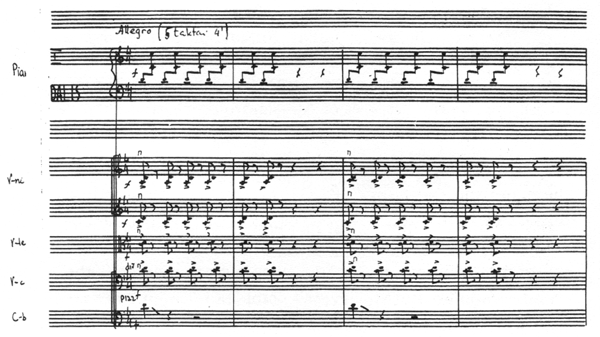
Example # 2
This is followed at R14 by a section that functions as a transition to the next movement. This section is scored for strings alone and is in two-part contrary motion counterpoint. At R16, a chordal reference is made to the opening motives of the work. A descending scale in the first violins leads directly into the next movement.
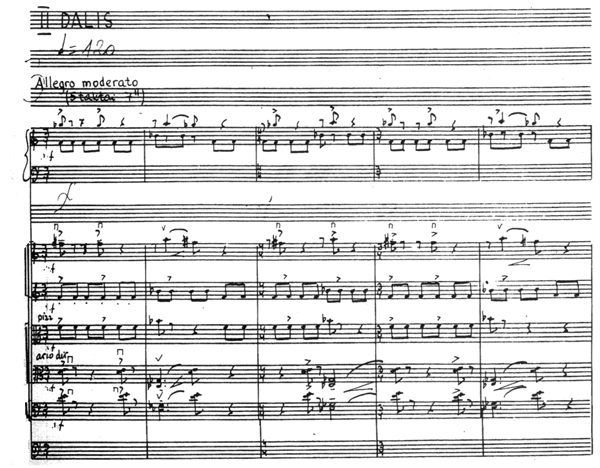
Example #3
The second movement begins with a minor 9th F-Gb in the piano and the strings. (Ex. 3) The call of the descending third A-F# is important as is the ostinato D-E against the Eb-Gb in the bass. These ideas are derived from materials from the first movement. As the present movement evolves, the textures become more active and complex through large interval leaps. A hocket (a medieval device of splitting melodic lines among the voices of the texture) appears at R6. Repeated notes prevail, leading to an emphasis on F# at R12, reflecting the use of this pitch in the first movement. Between R12 and R13, a two-note call is heard in the upper strings that increasingly dominates the movement. This alternates with the repeated notes and the A-F# idea. The movement dissolves with a combination of these motives as well as the Db-Eb idea that will end the last movement. In general, the harmonic structures are more dissonant in this movement than in the first.
The third movement continues the descending gesture from the previous movement. Repeated notes continue to play an important role, as does the D-E interval. (Ex. 4) At R3, the minor-third call is heard with expanding phrases in the violin. The G-C# tritone is emphasized, as are chord structures similar to those of the first movement.
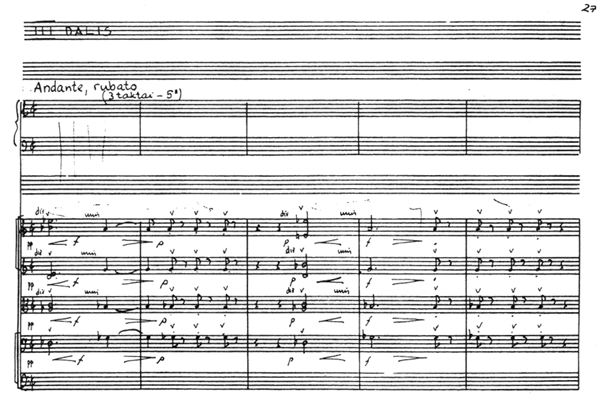
Example # 4
At R 5, a ritmico section begins with repeated C#s, thus creating a relationship to the two previous movements. This leads to the climax at R7 with dissonant quartal harmonies. At R9, the descending motive outlining a C#-G tritone is heard again. Parallel thirds provide contrast at RIO, leading to contrary motion at R12 and dissolving to the conclusion. This passage is related to the transition between the first and second movements. The emphasis on minor thirds is related to the "call" of the second movement. The final cadence reflects the gesture at the opening of the movement, but its inconclusive harmony leads into the finale.
The finale is the fastest and most energetic movement of the work. Repeated chords and notes are emphasized. F is a subtle tonal center, though obscured by the dissonances.
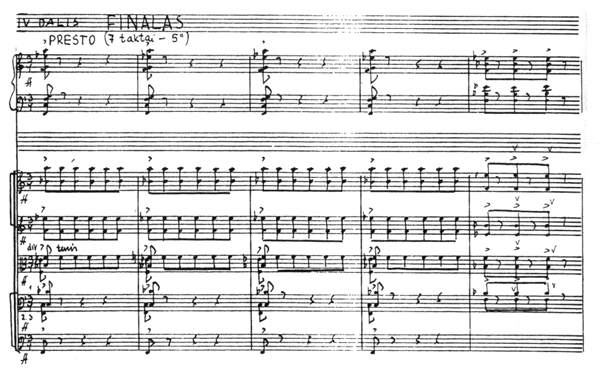
Example # 5
Arpeggios emphasizing C-F3 are soon heard in contrary motion as is the C-D interval from the beginning of the work. A hocket involving thirds and fourths is found at R2, combining and developing previous ideas. At R5, a varied return of the opening appears moving to the development of the idea in fourths. A transition at R9 leads at RIO to the return of the hocket emphasizing thirds, which builds to a climax at R12. At R14, the whole step idea from the beginning of the work returns, followed by a development and retransition to the movement's main idea at R21. This is the final section marked by the arpeggios in fourths, the dissolving D-Eb interval, and the final F major cadence, anticipated by the previous emphasis on F. Although these serene F major triads seem a surprising conclusion, they realize the earlier implication of F as an important tonal center.
In general, the finale highlights the quartal chordal structures presented in bitonal arpeggios. The C-F# tritone and the whole step pattern from the first movement are combined; thus the finale represents an intensification of the first movement. Hocket provides motivic development and rhythmic variety.
The special role of the piano is illustrated by a passage such as the following from the second movement. (Ex. 6) Here the piano supports the rest of the texture, occasionally adding to the density. It also contrasts phrases and section, such as at R7 of this movement, where it defines an important rhythmic pattern. At other points in the score, the piano reinforces the crescendi or provides color. The piano is never treated soloistically, for its role is always secondary.
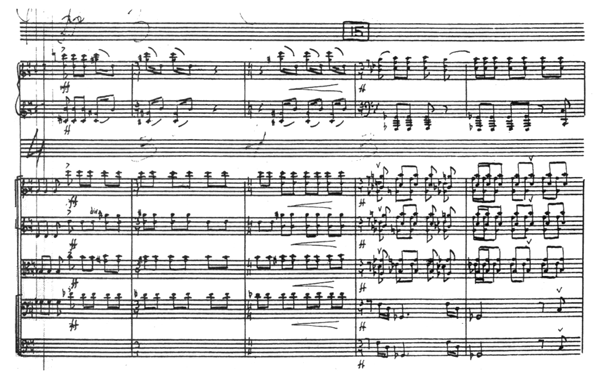
Example # 6
Conversely, the strings are often used percussively. Legato phrasing appears only briefly and principally in the slow movement to contrast with the other movements and to create longer, more cantabile phrases.
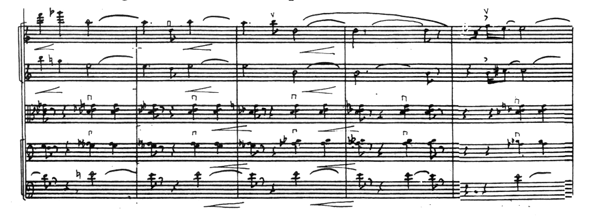
Example # 7
Although the harmonies are tonal, with usually quartal and modal implications, pungent dissonance often occurs as a result of the contrapuntal elaboration of motives. It is also typical that all 12 chromatic pitches are heard in rapid succession at climactic moments, creating many sections of atonal-ity. An example of this occurs at R22 of the finale. (Ex. 8) Such sections also are highlighted by dense dissonance: Thus despite the apparent conservatism of the Sinfonia, the harmonic-contrapuntal language is quite aggressive.
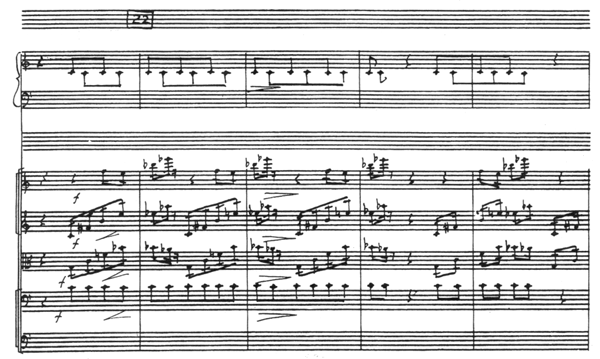
Example # 8
The following illustrates the Sinfonia Giocosa's general structure: Allegro (containing all the important motivic-harmonic material) - transition - Allegro moderato (elaborating material from the first movement, but with more atonal intervals) - Andante Rubato (marked by longer phrases, and many repeated notes, particularly C#s) - Presto (elaborating material from the opening movement). This last movement ends with material heard at the end of the second movement. It is notable that the movements dovetail and share common ideas, creating a work that is both economical and unified. F is increasingly affirmed as the tonal center, for it is implied in the second movement and becomes more overt during the finale.
In the same letter of 7 July 1999 quoted above, Mačakinas wrote:
These are some words about the style of my Sinfonia Giocosa. You rightly describe all my intentions in your article. I like open, elegant, intellectual games of sound, filled with my own Lithuanian mentality. This is the only acceptable way for me.
In conclusion, the Sinfonia Giocosa blends Neoclassicism and Lithuanian folkloric elements. Its clarity, interesting development of motives, and contrasting texture - often achieved through Rocket - make it one of Makačinas's finest works as well as an important addition to the contemporary literature for string orchestra.
A List of Makačinas's Principal Compositions:
Ashes of Pirčiupiui, cantata for choir and orchestra (1960)
Three Dances for Chamber Orchestra (1961)
Two Poems for flute, viola, and string orchestra (1962)
Autumn Watercolors for mezzo-soprano and piano (1962)
Suite No. 1 for piano (1963)
Sonata No. 1 for organ (1963)
Suite No. 2 for piano (1966)
Three Tales for mezzo-soprano and piano (1972)
Cantata to Vilnius for chorus and orchestra (1973)
Solar Poem for mezzo-soprano, chorus, and orchestra (1975)
Youth overture-poem (1981)
Suite No. 3 for piano (1981)
Tales About Bees for soloist and chamber ensemble (1983)
Six Named Suites for children's choir and orchestra (1983)
Symphony for chamber orchestra (1985)
Dialogues for two violins and organ (1986)
Sonata No. 3 for organ (1987)
Sonata for violin and piano (1987)
Sonata for clarinet and piano (1989)
The Lithuanian Book for organ (1989)
The Armenian Book for organ (1989)
Quintet for accordions (1990)
Sonata No. 4 for organ (1990)
Sinfonia Giocosa for chamber orchestra (1990)
Concerto for trumpet and chamber orchestra (1991)
Sonata No. 5 for organ (1993)
Sinfonietta for strings, percussion, and clavinova (1995)
Old Book for Organ (1996)
Sinfonietta for strings Pacem relinquo vobis (based on the Organ Sonata No. 5)
Reflections for string quartet or string orchestra (1999)10
1 "The Organ Sonatas of Teisutis Makačinas," Diapason (August, 1993): 12-13; 'The Organ Sonata No. 5 by Teisutis Makačinas," Diapason (May, 1996): 14.
2 "Katilius in America," Lituanus 44 (1998): 40-53.
3 Scott Messing, Neoclassicism in Music: From the Genesis of the Concept through the Schdnberg/Stravinsky Polemic (Rochester: University of Rochester, 1996), 129-32.
4 Ferruccio Busoni, "Young Classicism," in The Essence of Music and Other Essays, translated by Rosmanond Ley (New York: Dover, 1957), 20.
5 Quoted in German in Dorothee Eberlien, "Čiurlionis,
Przybyszewski und Vjaceslav Ivanov über die Musik um 1900," Acta Universitatis Stockholmensis 5 (1990): 667.
6 Eberlein, 667-8.
7 http://neris.mii.lt/heritage/lfcc/thelt/node27.html Consulted 5/26/99 at 10:22 AM.
8 Stravinsky uses Lithuanian folksongs in The Rite of Spring (1913). See Richard
Taruskin, "A Myth of the Twentieth Century: The Rite of Spring, the Tradition of the New, and Music Itself," Modernism/Modernity 2.1 (1995): 1-26.
9 This information is derived from GAIDA: 5th Baltic Music Festival (Vilnius: Lithuanian Composers' Union, 1995), 66-7.
10 This list is from GAIDA, 67 and supplemented from the letter of 7 July 1999.